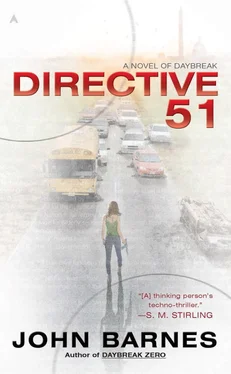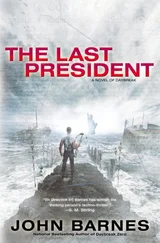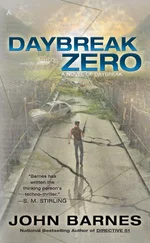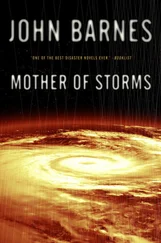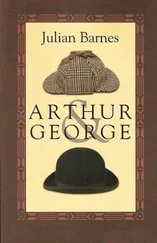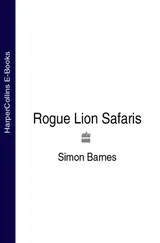The mushroom clouds looked odder still, distorting and stretching out to the east in a shape like a bucket-topped boot, with the toe sliding eastward. Normally they stay in the troposphere, he thought, where winds aren’t much more than a hundred miles an hour at most, but in the stratosphere and higher…
He bent, opened his pack, and pulled out his big map of the United States. Assume that he was only seeing the top parts of the mushroom clouds. Assume the bomb was so big you could feel the ground wave six hundred miles away. Orient the map with the compass…
Washington. And Chicago. I’m almost at the apex of an isosceles triangle of them.
Hit with bombs so big that the top of each mushroom cloud flew right into space.
By the time he had refolded the map, the morning sky was streaked, everywhere, with millions of shooting stars, bits of the mushroom cloud re-entering. Some of those shooting stars were still falling later on, when he had put a couple of miles behind him, stopped to enjoy a can of lychees and listen, and finally heard, right on schedule, the two terrible booms.
Whoever my readers are going to be, how the hell am I going to explain even the idea of bombs that big to them? He chewed that over as his feet put him on the road that would lead through McKinley and Lincolnsburg tomorrow; he preferred betting that the concrete-pier bridge would still be standing, rather than take his chances on a dam after shock waves like that. By the time he camped that night, in an east-facing clearing, he had several good analogies and was seeing diagrams in his head. Gotta find a printer, a graphic artist, and the capital of the United States, he added to his mental do-list, as he fell asleep in the cool, wet forest, a light rain just spattering on his tent. Nothing to it, really, if I just keep moving.
BEFORE. DURING. AND AFTER. EARTH. 12:30 P.M. GMT. TUESDAY. DECEMBER 3.
Each of the five flashes would have appeared as a tiny round dot—not a point, but a circle—to the naked eye of an observer standing on the moon, and though the flashes on the night side of the Earth, darker than it had been in more than a century, would have been more dramatic, the circular flares would have been visible even on Washington and Chicago, both in bright daylight.
From low Earth orbit, where the weather satellites orbited, the five mushroom clouds would have looked far more impressive; they were the five biggest nuclear bombs ever set off on Earth, each of them five times the power of the gigantic Russian test shot that had terrified the world sixty years before. The tops dispersed strangely, for they were literally in space—more than a hundred kilometers high. From orbit one could see the boundary where the particles of debris and smoke ceased to billow and separated into trillions of lines of fire, outlining a parabolic funnel like the top of a vase, cooling into invisible grit and pebbles that re-entered as bright streaks in all directions around the pillar of fire. Out to about 150 miles altitude, weather and communication satellites ran into the debris and were pounded apart by their own high velocity.
The maintenance vehicle shed for the East Potomac Golf Course, far down in the southwest corner, had long been superseded by a newer one on the north edge of the course, and so it had been unused for a long time; months before Daybreak, a succession of semi trailers, all with papers perfectly in order, had arrived and delivered a large number of crates into the unused shed. If anyone had looked at the papers seriously, they might have muttered, “Hunh, guess they’re finally doing something with that old tractor and truck shed.”
A few days later, an apparent group of joggers had noted a signal from a man with binoculars down a long fairway from themselves. Abruptly they had turned as one and sprinted through the side door on the shed, where the padlock had been cut and reattached so that it locked nothing. The “joggers” had not emerged for eight days, and when they did, they had slipped out at about six in the morning, running back the way they had come as if just finishing a morning run. Inside the shed, painted matte black to blend into the dark interior, a sphere nine meters in diameter sat with its top between the rafters of the old shed.
Beneath the black paint was steel three centimeters thick, covered on its inner surface with a tungsten-thorium foil, a special order made by a Chinese firm that didn’t ask what it was for (tungsten-thorium alloys are common in, among other things, jet engines and expensive specialty light bulbs; obviously someone wanted a super-dense conductor that was strong in thin sheets at high temperatures. Must be some new product, maybe we’ll see some of them in the store next year, the factory manager had thought).
Inside the steel sphere, resting on dozens of steel legs, there was a second sphere of thin plastic; no Daybreak biotes had penetrated because the outer sphere had no openings. The space between the two spheres was about a half meter, and in that space were 131 pure fusion devices, each identical to the device that had been destroyed in Air Force Two, and that had detonated inside Mad Caprice , weeks before. They were just about a meter apart, from center to center, and each one talked to its six nearest neighbors via a laser relay; the messages they sent each other were simply comparing their clocks, keeping each of them synchronized to the tenth of a nanosecond, such a small interval of time that each bomb, in its quiet every-second calculation, had to measure and compensate for the travel time of the light from all its neighbors a meter away.
Inside the thin plastic sphere was about 220 tons of lithium deuteride, the basic fuel for the H-bomb.
The programmed moment arrived. The sphere of 131 small fusion bombs—each only a twentieth of a kiloton—detonated, so nearly simultaneously that if anyone had been able to observe the gamma rays from each bomb, they would have been seen to meet at the centers of all the equilateral triangles between the bombs.
Radiation exerts pressure; the gamma rays from the fusion, moving at the speed of light, squeezed the lithium deuteride sphere to the density at the core of the sun. Arriving an instant later, the relativistic protons—hydrogen nuclei moving at close to the speed of light—held the immense ball of fusion fuel together, and compressed it even further.
Meanwhile, the protons that had not gone into the fusible mass collided with the tungsten-thorium foil, releasing a shower of hard X-rays, which further compressed the lithium deuteride at its center.
Technically, the material was now so compressed that it was no longer lithium deuteride but a dense soup of lithium and deuterium nuclei, pushed into each other by the terrible force; in a microsecond, a small fraction of the most-compressed fused into beryllium and released enormous energy; the ball of nuclei was further heated by that energy, yet held together by the incoming radiation. The added heat caused more fusion, releasing more heat and bringing on still more fusion.
An instant later, less than the time it would take for light to reach your eyes from a stoplight a mile away, the balance changed; the outward force from the fusion-heating of the sphere was greater than the inward force from the radiation.
The energy released.
The 250-megaton blast scooped out a crater 350 feet deep and nearly four miles across. The fireball was almost twenty-five miles across, and extended into the stratosphere in the first millisecond. President Norcross, his Cabinet, the Congress, the Supreme Court, and every living thing in the city had no time even to sense that anything was amiss; a signal could not cross a single synapse in their brains before they just ceased to be. Washington’s vaporized remains boiled upward so violently that when the cloud of plasma cooled enough for molecules to form again,much of it fell as glassy artificial meteors ranging in size from peaches to BBs, the farthest-flying ones landing in Iceland. The immense ground shock wave in the melted rock created concentric ridges every hundred yards or so for ten miles beyond the crater rim.
Читать дальше
